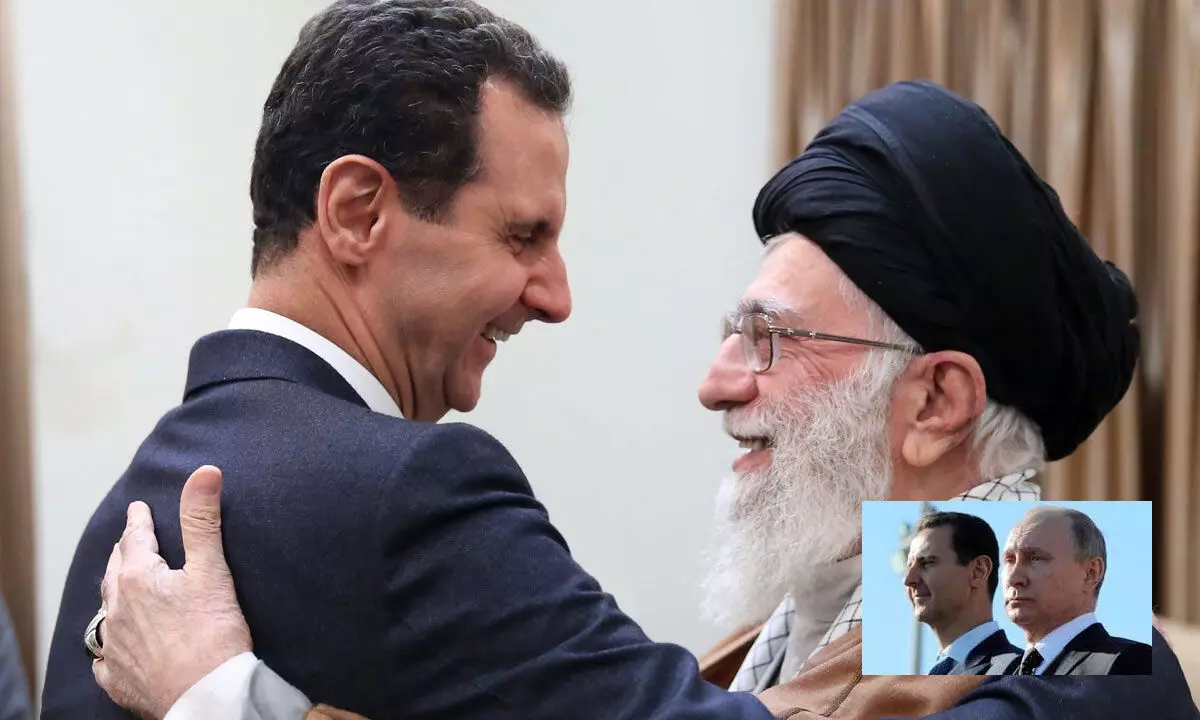Live
- Anjaneyaswamy’s Shobhayatra organised
- Jeevan Raksha Yojana: Congress promises Rs 25 lakh health insurance
- Releases preliminary answer key for Group-III exams
- Ensure better services to people: CM to babus
- Wrong spelling in ransom note helps police crack ‘kidnapping’
- Sambhal court to hear Masjid temple case on March 5
- Ganga dredging in Prayagraj environmental crime: Akhilesh
- Fatehpur shivers at 1.1 degrees as cold wave sweeps Raj
- Yogi govt develops dense forests
- AP set to become global digital tech hub says Lokesh
Just In
‘Axis of the vulnerable’ is cracking in Syria


The so-called “axis of the vulnerable” is breaking in Syria. Starting in 2016, Russia and Iran, propping up the regime of Bashar al-Assad, needed more than a year of bombing, ground assaults and siege to break the rebel opposition in the east of Syria’s largest city, Aleppo.
The so-called “axis of the vulnerable” is breaking in Syria. Starting in 2016, Russia and Iran, propping up the regime of Bashar al-Assad, needed more than a year of bombing, ground assaults and siege to break the rebel opposition in the east of Syria’s largest city, Aleppo.
Now, in 2024, the rebels needed less than four days to liberate the city and most of Aleppo province. They also regained territory in neighbouring Idlib province and moved south into northern Hama before the Assad regime established defensive lines.
Russian forces remained in their bases on the Mediterranean. And Iran and its Lebanese ally Hezbollah were caught by the rebel advance in their positions in north-west Syria. They abandoned them, but not before at least two commanders were slain.
Since 2020, after Russia and Iran helped his forces roll back the opposition in much of Syria, Assad has presided in name over part of a fractured country. He and his allies held most of the largest cities, includ-ing Aleppo and the capital Damascus, while Turkish-backed opposition groups controlled most of north-west Syria and US-backed Kurdish factions had autonomy in the north-east.
Now Assad does not even preside over his share of the partition. And his Russian and Iranian enablers, overstretched and isolated by much of the world, are not in a position to restore his paper rule.
Propping up Assad
From the start of Syria’s uprising against the longtime rule of the Assads in March 2011, Russia and Iran provided political, logistical, intelligence and propaganda assistance to the Assad regime. Iran effectively took over the Assad military from September 2012, training tens of thousands of militiamen to fill de-pleted forces. Hezbollah sent in its fighters from 2013 to save the Assad regime near Lebanon’s border. And Russia intervened with special forces and air power from September 2015.
Much of the success of Assad and his allies lay in their ability to wear down the international community. The Kremlin spread disruptive disinformation to cover for the regime’s deadly chemical attacks and to denigrate opposition activists and Syria’s White Helmets civil defence. The Obama administration, rather than holding the regime to account, was led by the nose into fruitless discussions of a ceasefire. The EU was sidelined, the UN rendered impotent, and Arab governments eventually sat on their hands.
While the regime could count on outside assistance, it could maintain the illusion of power. But then Russian president Vladimir Putin gambled on his invasion quickly conquering Ukraine in 2022. Almost three years later, he has poured most of Russia’s resources into operations there and has put the country under international economic pressure.
Iran’s leadership has been beset by mass protests over social issues including women’s rights. The econ-omy is still staggering between inefficiency and sanctions. So, when the rebels attacked last week, they were not facing a vaunted axis of resistance. They saw only the disappearing shadow of Assad’s supposed authority.
Turkey playing a pivotal role
Where next for Assad and his backers? The answer could now lie with Turkish president, Recep Tayyip Erdoğan. Erdoğan may not have launched the rebel offensive – sources say Abu Mohammad al-Jolani, the leader of the Islamist faction Hayat Tahrir al-Sham, made the decision – but he is the beneficiary of the outcome. Turkey’s political and economic reach in north-west Syria has expanded since 2016 to in-clude the country’s largest city.
Ankara has leverage over the terms of negotiations. It can encourage and even equip the rebels to press on, or it can call for a halt and consolidation in preparation for a sit-down with the Russians and Iranians. The Turkish foreign minister, Hakan Fidan, has already hosted his Iranian counterpart in a show of di-plomacy.
But that raises further questions. Erdoğan’s primary foe in Syria is not Assad but the Kurdish authorities, whom he views as part of the Turkish-Kurdish insurgency group, the Kurdistan Workers’ party.
But will Turkey accept this or, as in 2019, will it pursue an attack on the north-east? Ankara has reported-ly initiated talks with the Assad regime about a Turkish-controlled “buffer zone” well inside the border.
That brings in the US, which has been the essential backer of the Kurds and the SDF. For now, Washing-ton is likely to maintain that commitment. But from January, all bets are off because Donald Trump is returning to the White House. After a phone call with Erdoğan in late 2018, Trump tried to withdraw all US troops from Syria. He was outmanoeuvred by the Pentagon, but another call with Erdoğan in October 2019 green-lit a Turkish cross-border invasion. The axis of the vulnerable is breaking, but Syria’s era of uncertainty continues. Syrian citizens can only hope that now it is not so deadly or destructive.
(https://theconversation.com/)

© 2024 Hyderabad Media House Limited/The Hans India. All rights reserved. Powered by hocalwire.com






